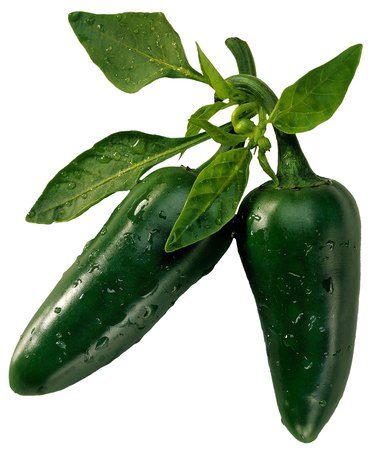
Like any other garden plant, jalapeno pepper plants require proper cultivation to stay healthy and yield a bountiful crop. The jalapeno is a sun-loving, warm-season vegetable that grows up to 3 feet high, so give it ample growing room. Jalapeno peppers, like other nightshade vegetables, need a sufficient amount of water to keep the soil evenly moist, but not waterlogged. Jalapeno pepper plants that develop dark spots on the fruits and leaves indicate that a cultivation problem is present.
Bacterial Leaf Spot
Video of the Day
A variety of bacteria cause lesions on jalapeno pepper plant leaves that are known collectively as bacterial leaf spot. On young leaves the spots occur as a small pale yellow-green spots, and on older leaves as larger, dark brown or black spots with yellow centers. Sometimes a dark-colored ooze comes out of the center. Older leaves turn yellow and fall off. If the disease matures enough that it infects the jalapeno pepper plant may die. Remove infected areas immediately and spray with a copper-based fungicide in seven to ten day intervals to protect new growth.
Video of the Day
Anthracnose
Dark, circular sunken spots of varying sizes on young and mature fruits may indicate the jalapeno pepper plant is infected with anthracnose. Look for pink, red, yellow or orange spore pads in the middle of the lesions. The jalapeno pepper disease may not even show up until fruiting begins. It thrives during periods of heavy rainfall or when the pepper plants are over-watered or irrigated using overhead watering methods. Avoid improper watering practices, remove infected plant areas, and don't work with the jalapeno pepper plants when they are wet. Apply a Bordeaux mix, which is a sulfur, copper and hydrated lime fungicide that prevents the disease from spreading.
Blossom-End Rot
Jalapeno peppers that develop large, dark, water-soaked areas on the bottom of the fruits have blossom-end rot. The spots enlarge and darken from brown to black over time, and mold may grow on the spots. It's a physiological disorder that is caused from a combination of improper cultural practices. Fertilizing with too much nitrogen, excess soil salts, uneven and arbitrary watering and a deficiency in calcium lead to blossom-end rot. Although blossom-end rot is difficult to eliminate, it can be controlled by watering regularly, avoiding high-nitrogen fertilizers, planting in well-drained soil, and adding calcium-containing fertilizer.
Sun Scald
When the fruits of the jalapeno pepper plant develop pale, wrinkled, soft spots that eventually dries out and becomes covered with black mold, the pepper plant has developed sunscald. when the jalapeno pepper fruits are directly exposed to sunlight, they become burned by the heat. It's especially problematic for young fruits or early fruiting pepper plants that haven't produced enough foliage to protect the jalapeno peppers. Sunscald is also a problem in jalapeno pepper plants with leaf diseases that have caused premature defoliation. Prevent sunscald by preventing leaf diseases and fertilizing to promote sufficient foliage growth.